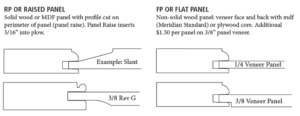Cabinet Component Basics: What You Need to Know
By Katie Van Blargan, Meridian Customer ServiceKitchens are one of the most popular spaces in a house and can be considered the heart of a home. That’s because this space gets plenty of daily use from a variety of family members, in addition to serving a number of important purposes.
And when it comes to the kitchen, the cabinets are one of the most distinctive, prominent, and important features. Although trends can come and go – according to the National Kitchen & Bath Association’s newly released 2024 Kitchen Trends Report, previously popular white cabinets are now out of favor and warm wood finishes are in – true craftmanship and design never go out of style.
Meridian Products has been providing custom cabinetry components to cabinet manufacturers on the East Coast and east of the Mississippi for four decades. And our team is dedicated to obtaining the highest level of quality when it comes to custom cabinetry components.
So, when it comes to your kitchen cabinets, or any type of cabinet for that matter, it’s important to understand a cabinet’s basic components. This is important because there are several key parts, and each one serves a specific function.
Cabinet Box/Carcass:
The cabinet box consists of the sides, back, bottom/floor, and top/stretcher. The vertical panels form the left and right sides of the cabinet. The back or rear panel provides stability and support to the cabinet structure. The bottom/floor is comprised of a horizontal panel at the base of the cabinet. And the top/stretcher is the horizontal panel at the top and is often used in base cabinets to provide additional support.
Face Frame:
The face frame is composed of stiles or midstiles, which are the vertical framing pieces that run top to bottom. These are on the left and right sides, but can also be throughout the center, based on the number of openings desired. The framing pieces that run left to right are referred to as rails or midrails. These can be placed throughout the frame depending on the number of openings desired.
Doors:
The doors feature both stiles and rails. The panels, which are the central part of the door, can be either flat or raised. The hinges are the hardware that attach the door to the cabinet box and allow the door to open and close.
Drawers Boxes:
A drawer box consists of four parts: the front, the sides (the horizontal panels on the left and right sides of the drawer), the back or rear, and the bottom, which is the veneer cored material forming the base of the drawer. The slides or guides are the hardware mounted on the sides or bottom that allow the drawer to move in and out smoothly.
Toe Kick:
This is the recessed area at the bottom of base cabinets.
Optional Components:
Cabinet Top: In some cabinets, especially wall cabinets, the top panel is present to enclose the cabinet fully.
End Panels: Decorative panels that are attached to the visible sides of cabinets to match the doors.
Crown Molding: Decorative trim added to the top of wall cabinets for a finished look.
Setback and Panel Insert
Terminology throughout the wood industry can vary between vendors and the craftsmen themselves. Trying to do a quick Google search on cabinet terminology can make things even more confusing. So, let’s focus on two terms that are especially important to know when it comes to cabinets, but we can easily get hung up on.
First and foremost is setback. This term is important when it comes to cabinet doors and the face frame. Meridian defines setback as how far the inside framing is setback to the face of the panel. Setback can vary depending on door thickness, along with the frame profile that is chosen. There are, however, standards that are set for specific thickness. On a ¾ inch, your standard setback is 3/8 inch. On a one-inch door, your standard setback is half an inch.

The second term we want to address is the panel insert. When using this word, contractors and vendors are referring to how far the panel is inserted into the panel plow. Meridian inserts the panel into the panel plow 5/16 of an inch. The images below depict this. The void that you see in the picture allows Meridian to place space balls in, which gives the panel room to expand and contract accordingly when temperature and humidity fluctuation are present.

As you can see, each part of a cabinet plays a vital role in its functionality and aesthetics. By understanding the basics of a cabinet’s components, you will be better equipped for your next building project. To learn more about Meridian’s latest products and industry trends, visit our website.
